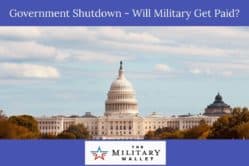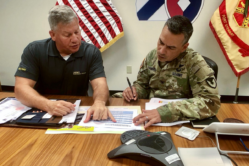Separation from dependents is an unfortunate aspect of the military lifestyle. Fortunately, if your dependents cannot live at or near your permanent duty station, you may be entitled to Family Separation Allowance (FSA). You can qualify for FSA payments, whether inside or outside the United States.
FSA payments don’t make up for separation from loved ones. But, the payments help ease the financial strain caused by separation due to military orders. There are two types of Family Separation Allowance, FSA I, and FSA II. Both types have different criteria a service member must meet to qualify for payment.
Family Separation Allowance Type I
Type I FSA is an additional “housing allowance” payment. It is made to any service member forcefully who is separated from their dependents and must live off base. The FSA is paid alongside any other housing allowance already being paid.
Type I FSA serves to assist military families with the added housing expenses caused by forced family separation. The following scenarios may qualify you for FSA I:
- Transportation of your dependents to the new permanent duty station or to a place near that duty station is not authorized at government expense. Or your dependents do not live at or near the permanent duty station is referred to as FASFSA-Restricted (FSA-R).
- Transportation of dependents is authorized at government expense, but you have elected an unaccompanied tour of duty because a dependent cannot accompany you to the permanent station due to certified medical reasons.
- Adequate government quarters or housing facilities are not available for assignment to a member and the member is instructed to reside off-base.
- You may also be entitled to FSA I if your dependents have to be evacuated from a danger area and must temporarily occupy government quarters at a safe haven area. According to the Defense Finance and Accounting Service, “A safe haven location may be anywhere in the world named in the evacuation order, or subsequent modification to that order, to which a dependent is directed to relocate on a temporary basis to await a decision by competent authority to either return to the OCONUS permanent duty station or proceed to a designated place. (Reference DoDFMR Vol. 7A chapter 27).”
Essentially, anytime military orders cause a service member with dependents to live in a separate housing unit, the service member may apply for FSA I.
Family Separation Allowance Type II
Type II FSA is granted when military orders separate a service member from their dependents for 30 days or longer. For example:
- If the service member is serving duty aboard a ship that is away from the homeport continuously for more than 30 days, they will qualify for FSA-Ship (FSA-S).
- A service member on temporary duty (TDY) or temporary additional duty away from their permanent duty station continuously for more than 30 days, and the member’s dependents are not residing at or near the TDY station, may qualify for FSA-Temporary (FSA-T). FSA-T includes members who must serve a TDY before reporting to their initial station of assignment. For example, any new service member going through basic training would qualify for FSA-T due to being away from their dependents for 30 or more continuous days.
FSA Guidelines
- FSA is a payment only available to service members with dependents.
- All service members must submit a Statement to Substantiate Payment of Family Separation Allowance (DD Form 1561) to their servicing personnel office in order to apply for FSA payments.
- A service member can qualify for both FSA I and FSA II simultaneously during the same time period. Both types are payable along with any other per diem payments or allowances already granted. FSA is payable at the rate of $400 per month. It can also be pro-rated to $13.33 per day for periods less than a month.
- Family separation must be involuntary to receive FSA payments. In other words, dependents may not accompany a service member at government expense.
- Temporary social visits to the service member’s duty station may not exceed 3 months. If the visit exceeds 3 months of time, the FSA payments will discontinue until the dependents’ departure.
- Effective October 1, 2008, when both members of a married couple are members of the uniformed services, regardless of whether they are serving in the same or different branches of military service, they will both qualify for FSA payments. However, to qualify, the couple must have been residing together with their dependents before being assigned to duty assignments resulting in an involuntary separation of the family. Each service member will receive the full FSA payment from the date of detachment from the old permanent duty station (or the first day of authorized travel if authorized proceed time or leave is involved) until he or she is no longer assigned to the qualifying duty assignment. The FSA would continue for the other service member until they no longer serve under the FSA qualifying duty assignment.
Easing the Financial Strain of Separation
Any period spent away from dependents can be trying and stressful. Family separation allowance payments help to ease the financial strain caused by both short and long-term separation.
Whether you have a temporary duty station, sea trials, deployment, training schools, or any other duty assignment which causes a continuous 30-day or longer separation, the FSA acts as a boon to get your through to the other side when you’ll be able to see your dependents again.
If you have other pay or allowance questions, check out the new Military Pay app by Military.com. It’s available for both iOS and Android. The app offers a military pay calculator. It also has other resources to help answer questions related to monthly or annual service pay.



Comments:
About the comments on this site:
These responses are not provided or commissioned by the bank advertiser. Responses have not been reviewed, approved or otherwise endorsed by the bank advertiser. It is not the bank advertiser’s responsibility to ensure all posts and/or questions are answered.
Bella says
I have 4 dependent and I was try to bring one to my current location. Would this disqualified me from getting family separation allowance
Sojuforces says
Currently going through separation process and I am in Korea. I am already giving half my BAH to my spouse for supporting our child, are they entitled to my FSA as well or does it get split with the BAH as well?
Sean Moody says
I am not being allowed to received family separation pay even when I am in a restricted 12 month tour and have 50/50 custody. Its like I have no daughter and the army counts me as someone with no family. Is there anything I am missing that I should receive something for this
Heather says
My husband is current at basic training and when he requested to visit Finance to look into separation pay, his drill sergeant didn’t think he would get it during training so wouldn’t let him go… This is the most recent article I can find online regarding separation pay during training. Are there other resources I can look into, as a spouse, to confirm if this is possible? Thanks!
Ryan Guina says
Hi Heather, you should be able to call a base finance office for further assistance. Just explain the situation to them and they should be able to tell you if you will be eligible or not. As for the pay, if he is eligible, he should be able to file for it once he arrives at his first official duty station.